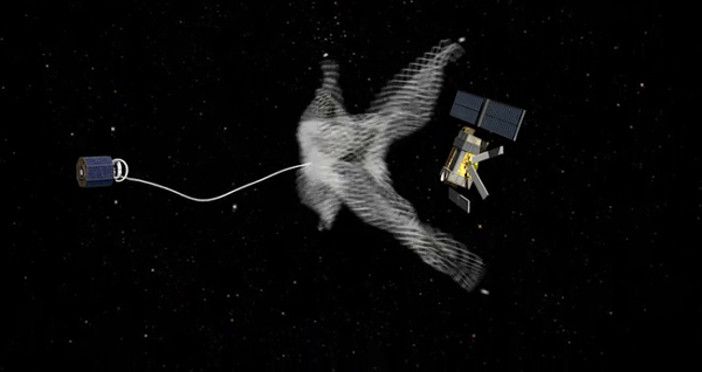The RemoveDebris European project has successfully tested a harpoon system for removing debris from space.
According to the US Space Surveillance Network there are 40,000 defunct objects, more than 7,600 tonnes of space junk, in and around Earth’s orbit. Some are moving as fast as 30,000mph (48,000km/h).
During the test a harpoon was deployed at 20m/s from a spacecraft into a satellite panel attached to a 1.5m (5ft) from the same spacecraft. The harpoon penetrated the target, demonstrating its capability to capture space debris.
The harpoon test is the third successful test and follows the deployment of an on-board net to capture a simulated piece of debris, and the trailing of a LiDAR and camera based vision navigation system to identify space junk.
Researchers are now preparing for the final experiment next month, which will see RemoveDebris inflate a sail that will drag the satellite into Earth’s atmosphere where it will be destroyed. Destruction in the atmosphere is another method for disposing of old satellites and space vehicles.
Professor Guglielmo Aglietti, director of the Surrey Space Centre at the University of Surrey, said, “The harpoon was RemoveDebris most demanding experiment and the fact that it was a success is testament to all involved. The RemoveDebris project provides strong evidence of what can be achieved with the power of collaboration – pooling together the experience across industry and the research field to achieve something truly remarkable.”
Chris Burgess, harpoon lead engineer at Airbus Defence and Space, said, “The successful demonstration in space of the harpoon technology is a significant step towards solving the growing issue of space debris.”
RemoveDebris is a small satellite mission to test four Active Debris Removal experiments. The satellite is designed, built and manufactured by a consortium of space companies and research institutions, led by the University of Surrey in the UK. The spacecraft is operated in orbit by engineers at Surrey Satellite Technology in Guildford, UK. The project is co-funded by the European Union.
Read more on the RemoveDebris project, including its developmental testing, here.





